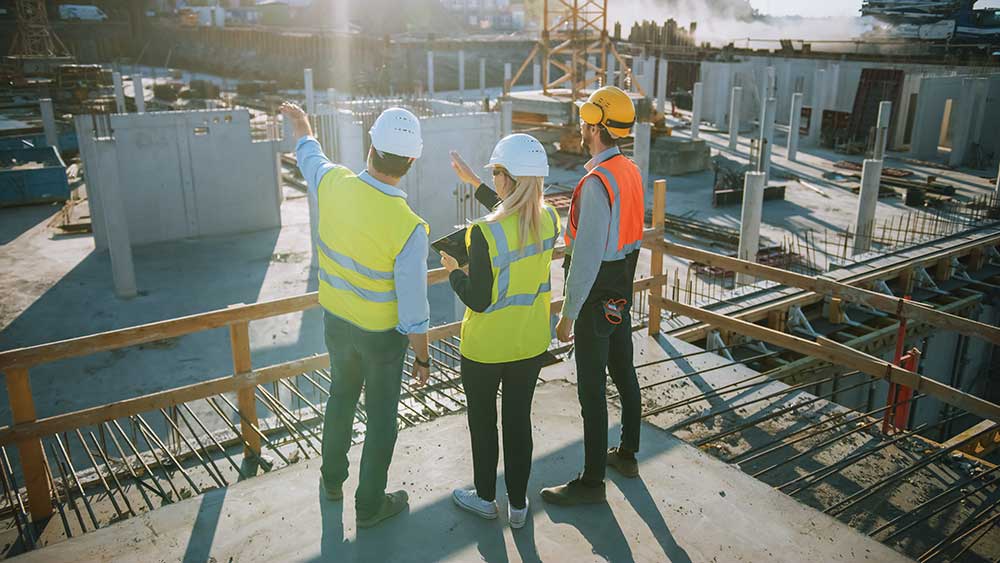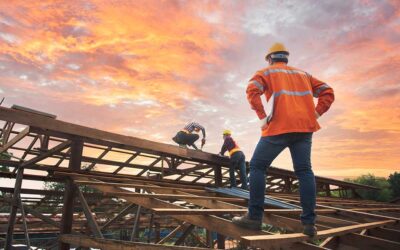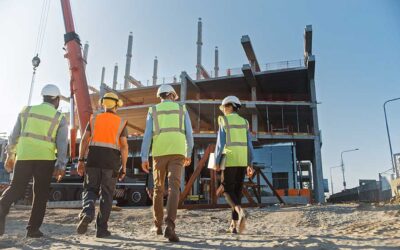Commercial vs. Residential Construction
Commercial and residential construction are two distinct branches of the construction industry, each with unique characteristics and requirements. Understanding the differences between them is crucial for anyone involved in the field. This section will delve into commercial and residential construction disparities, highlighting what sets them apart.
Project Scale and Purpose
Commercial:
Commercial construction projects are typically larger, focusing on non-residential structures like office buildings, shopping centers, hotels, and industrial facilities. The primary purpose is to facilitate business operations and generate revenue.
Residential:
Residential construction revolves around building homes, apartments, or housing complexes. These projects aim to provide living spaces for individuals and families, emphasizing comfort and functionality.
Regulations and Codes
Commercial:
Commercial construction adheres to specific zoning laws, building codes, and regulations that vary by location. Compliance with safety standards is paramount due to a higher number of occupants.
Residential:
Residential construction must meet local residential building codes and zoning regulations. While safety is essential, the emphasis is on creating comfortable living environments.
Design Complexity
Commercial:
Commercial buildings often feature intricate architectural designs and layouts tailored to the needs of businesses. This may include open office spaces, specialized infrastructure, and unique façades.
Residential:
Residential construction prioritizes designs that cater to the preferences and needs of homeowners. It focuses on creating functional and aesthetically pleasing living spaces.
Construction Materials
Commercial:
Commercial projects may require a broader range of materials, including steel, concrete, glass, and specialized components, to meet structural and design demands.
Residential:
Residential construction commonly uses traditional materials like wood, brick, and concrete, focusing on cost-effectiveness and comfort.
Project Duration
Commercial:
Due to the scale and complexity, commercial construction projects often have longer durations. Delays can be costly, impacting businesses’ operations.
Residential:
Residential projects are generally quicker to complete, with less risk of business disruption. Timeliness is essential to meet homeowner expectations.
Budget and Funding
Commercial:
Commercial construction projects usually involve substantial budgets, often funded by investors or businesses. They require careful financial planning and management.
Residential:
Residential construction budgets are typically funded by individual homeowners or property developers, focusing on cost control.
Commercial and residential construction differ in scale, purpose, regulations, design complexity, materials, project duration, and budget considerations. These distinctions highlight the need for specialized knowledge and expertise in each construction industry sector.
Types of Commercial Construction
Commercial construction encompasses a diverse range of projects, each with its unique characteristics and requirements. These projects serve various industries and purposes, contributing to economic growth and infrastructure development. In this section, we’ll delve into the different types of commercial construction, shedding light on their distinct features and significance.
Retail Construction
Retail construction focuses on building structures like shopping malls, retail stores, and outlets. These spaces are designed for functionality and to create an appealing shopping experience for customers. They often incorporate attractive facades, spacious interiors, and amenities to attract shoppers.
Office Building Construction
Office building construction involves the creation of office spaces, corporate headquarters, and commercial complexes. These structures are designed to accommodate businesses of all sizes, offering versatile layouts and modern amenities to meet the needs of professionals.
Hospitality Construction
Hospitality construction encompasses hotels, restaurants, resorts, and entertainment venues. These projects require a focus on comfort, aesthetics, and guest experience. They often feature intricate interior designs, landscaped areas, and amenities like pools, spas, and restaurants.
Healthcare Facility Construction
Healthcare facility construction includes hospitals, clinics, and medical offices. These structures demand specialized designs to meet stringent healthcare regulations. Patient privacy, accessibility, and medical equipment integration are crucial in this sector.
Industrial Construction
Industrial construction involves the development of warehouses, factories, manufacturing plants, and distribution centers. These projects prioritize functionality, durability, and efficient use of space to accommodate heavy machinery and storage needs.
Educational Building Construction
Educational building construction includes schools, colleges, and universities. These structures must create conducive learning environments while considering safety, accessibility, and technology integration for modern education.
Mixed-Use Developments
Mixed-use developments combine various commercial and residential elements in a single project. These versatile spaces integrate retail, office, residential, and entertainment components, fostering vibrant communities and reducing the need for extensive commuting.
Commercial construction is a dynamic field, continually evolving to meet the demands of various industries and the changing needs of society. Understanding the nuances of each type of commercial construction is crucial for professionals in the industry, as it enables them to deliver projects that align with their client’s objectives.
Key Players in Commercial Construction
In the vast world of commercial construction, several vital players collaborate to bring projects to fruition. Understanding the roles and responsibilities of these individuals and entities is essential for a smooth and successful construction process. Let’s delve into the various stakeholders who play crucial roles in commercial construction:
- Developers
- Developers are often the driving force behind commercial construction projects. They conceive the idea, secure funding, and make strategic decisions about the project’s scope and goals. Their vision shapes the entire development process.
- Architects and Designers
- Architects and designers are responsible for creating the conceptual and structural design of the building. They work closely with developers to ensure the project aligns with the vision while meeting regulatory requirements and safety standards.
- General Contractors
- General contractors are the project managers. They oversee all aspects of construction, including hiring subcontractors, coordinating schedules, managing budgets, and ensuring that the project is completed on time and within budget.
- Subcontractors
- Subcontractors are specialists in various construction trades, such as plumbing, electrical work, HVAC installation, and more. The general contractor hires them to carry out specific tasks within the project.
- Engineers
- Engineers, including civil, structural, mechanical, and electrical engineers, provide the technical expertise to ensure the building’s systems and structures are sound and compliant with regulations.
- Project Managers
- Project managers work closely with the general contractor and oversee day-to-day operations on the construction site. They are responsible for scheduling, quality control, and ensuring the project stays on track.
- Construction Workers
- Skilled and unskilled laborers are the backbone of any construction project. Carpenters, masons, electricians, plumbers, and laborers are responsible for physically building the structure according to the plans and specifications.
- Inspectors and Code Officials
- Government inspectors and code officials ensure the construction project complies with local building codes and regulations. They conduct inspections at various stages of construction to verify safety and adherence to standards.
- Suppliers and Material Providers
- Suppliers and material providers furnish the necessary construction materials, from concrete and steel to fixtures and finishes. Their timely deliveries are critical to keeping the project on schedule.
- Real Estate Professionals
- Real estate professionals, including brokers and agents, play a role in identifying suitable locations for commercial construction projects and facilitating property transactions.
- Financial Institutions and Investors
- Financial institutions provide loans and financing to developers, while investors may contribute capital to the project. Their financial support is integral to getting construction off the ground.
- Environmental Consultants
- In cases where environmental considerations are paramount, environmental consultants assess the impact of construction on the surrounding environment and help implement sustainable practices.
- Legal Advisors
- Legal advisors handle contracts, permits, and any legal issues during construction. They ensure that all parties are protected and that the project meets legal requirements.
- Safety Professionals
- Safety professionals oversee workplace safety and ensure construction sites adhere to safety protocols and regulations to prevent accidents and injuries.
In the intricate world of commercial construction, each of these key players contributes a unique expertise to bring complex projects to fruition. Their collaboration and knowledge are vital to the success of every commercial construction endeavor.
Phases of Commercial Construction
Commercial construction is a complex and multifaceted process that involves several key phases, each crucial to the successful completion of a project. Understanding these phases is essential for anyone interested in the construction industry or considering embarking on a commercial construction project. In this section, we will explore the various phases of commercial construction in detail.
- Planning and Design
The journey of a commercial construction project begins with meticulous planning and design. During this phase, architects, engineers, and project managers collaborate to create a comprehensive blueprint for the project. They consider the client’s requirements, budget, zoning regulations, and environmental impact. The outcome is a detailed design that outlines the structure’s layout, materials, and construction methods.
- Pre-Construction
Before the actual construction work begins, there’s a pre-construction phase. This stage involves securing permits, finalizing contracts, and assembling the project team. It’s also when the project budget is refined, and a detailed construction schedule is established. Additionally, risk assessments and safety plans are developed to ensure the safety of workers and the surrounding community.
- Site Preparation
The construction site must be prepared once all the necessary approvals and documentation are in place. This involves clearing the land, grading, and ensuring proper drainage. Site preparation sets the stage for the construction process by creating a safe and level foundation for the structure.
- Foundation and Substructure
The foundation and substructure phase involves laying the groundwork for the building. This includes excavating for the foundation, pouring concrete, and installing footings, piles, or caissons as needed. It’s a critical step, as the stability of the entire structure depends on a solid foundation.
- Superstructure
The superstructure phase is where the building begins to take shape. Structural elements such as walls, columns, and beams are constructed. This is also when the building’s core components, including plumbing, electrical, and HVAC systems, are installed. Quality control and inspections are vital during this phase to ensure that everything aligns with the design and safety standards.
- Enclosure
Once the superstructure is in place, it’s time to enclose the building. This involves adding exterior walls, roofing, and windows. Proper insulation and weatherproofing are critical to protect the interior from the elements and maintain energy efficiency.
- Interior Finishes
During this phase, the interior of the building is transformed into functional spaces. Interior finishes include flooring, wall coverings, paint, cabinetry, and fixtures. Attention to detail is paramount to achieving the desired aesthetics and functionality.
- Mechanical and Electrical Systems
Installing mechanical and electrical systems, such as heating, ventilation, air conditioning (HVAC), electrical wiring, and plumbing, is crucial in making the building operational. These systems ensure the comfort and functionality of the space.
- Exterior Landscaping and Site Work
The final touches of a commercial construction project involve landscaping and site work. This includes the installation of sidewalks, parking lots, green spaces, and any outdoor amenities. Landscaping adds curb appeal and functionality to the property.
- Commissioning and Handover
Before the building can be occupied, it undergoes commissioning—a thorough testing and verification process to ensure all systems work as intended. Once everything is validated and approved, the project is handed over to the client, marking the completion of the commercial construction journey.
Commercial Construction Materials
Commercial construction relies on various materials that form the backbone of any successful project. These materials are carefully selected to ensure durability, functionality, and compliance with local building codes and regulations. This section will delve into the key materials used in commercial construction, their characteristics, and the factors influencing their selection.
Structural Steel and Concrete
- Commercial construction often begins with the choice of structural materials. Two of the most commonly used materials are structural steel and concrete.
- Structural Steel: Renowned for its strength and versatility, structural steel is a popular choice for framing commercial buildings. Its high tensile strength makes it ideal for withstanding heavy loads, while its malleability allows for innovative designs.
- Concrete: Concrete is another crucial material in commercial construction. It’s prized for its durability and fire resistance. Reinforced concrete is often used for foundations, columns, and beams, providing stability and support to the structure.
Exterior Cladding
- Choosing exterior cladding materials impacts a building’s aesthetics, energy efficiency, and maintenance requirements.
- Brick and Stone: These materials offer timeless appeal and durability. They provide excellent insulation and weather resistance, reducing long-term maintenance costs.
- Glass Curtain Walls: For a modern and sleek appearance, glass curtain walls are often used. They maximize natural light and provide energy efficiency benefits.’
Roofing Materials
- Roofing materials are critical in protecting a commercial building from the elements.
- Single-Ply Membranes: PVC and TPO membranes are lightweight and energy-efficient options. They offer durability and are easy to install.
- Metal Roofing: Metal roofing is known for its longevity and ability to withstand harsh weather conditions. It’s a sustainable choice due to its recyclability.
Flooring
- Flooring materials in commercial spaces must balance aesthetics, durability, and functionality.
- Commercial-Grade Carpeting: Carpet tiles are popular for offices and retail spaces. They offer comfort underfoot and can be easily replaced if damaged.
- Vinyl and Laminate Flooring: These materials are known for their affordability, ease of maintenance, and wide design options.
Insulation
- Proper insulation is essential for regulating temperature, reducing energy costs, and ensuring occupant comfort.
- Fiberglass Insulation: This common insulation material offers excellent thermal performance and is cost-effective.
Sustainable Materials
- As sustainability becomes increasingly essential, commercial construction is incorporating eco-friendly materials.
- Recycled Content: Using materials with recycled content, such as recycled steel or reclaimed wood, reduces the environmental impact.
- Low-VOC Paints: Volatile organic compounds (VOCs) in paints can be harmful. Low-VOC or VOC-free paints are healthier options.
- Choosing the suitable materials is a crucial step in commercial construction, impacting the building’s appearance, performance, and sustainability. Each material, from structural elements to finishes, specifically creates safe and functional commercial spaces.
Safety and Regulations
Commercial construction sites are bustling hubs of activity, with heavy machinery, intricate processes, and multiple teams working in tandem. Safety is paramount to protect both workers and the public. Here are some key aspects to consider:
- Occupational Safety and Health Administration (OSHA):
- OSHA, a federal agency in the United States, sets and enforces safety and health regulations for construction sites. This includes guidelines for fall protection, electrical safety, and hazardous materials handling.
- The blog can provide statistics on how OSHA regulations have reduced construction accidents over the years, emphasizing the positive impact of regulatory compliance.
- Personal Protective Equipment (PPE):
- Workers on commercial construction sites must wear appropriate PPE, including hard hats, safety goggles, gloves, and steel-toed boots.
- Mention the importance of PPE in preventing common construction injuries like head trauma and eye injuries. Highlight any technological advancements in PPE, such as intelligent helmets or augmented reality glasses.
- Site Inspections and Audits:
- Regular inspections and audits are conducted to ensure compliance with safety regulations. This may involve third-party inspections or internal safety officers.
- Discuss how technology, such as drones and AI, is used for more efficient and thorough site inspections, contributing to improved safety.
- Emergency Response Plans:
- Every commercial construction project must have a detailed emergency response plan in case of accidents, fires, or other unforeseen events.
- Explain the importance of these plans and how they are communicated to all workers on the site.
- Environmental Regulations:
- Compliance with environmental regulations is crucial in commercial construction. This includes proper disposal of hazardous materials, adherence to emissions standards, and protection of natural habitats.
- Mention any green construction practices and sustainable materials increasingly used to meet environmental regulations.
- Worker Training and Certification:
- Workers need to undergo specialized training and certification for specific tasks, such as crane operation, welding, or operating heavy equipment.
- Discuss the role of technology in training, like simulators and virtual reality, which enhance the learning experience while reducing risks.
- Public Safety Measures:
- Commercial construction often takes place in urban areas, requiring special considerations for public safety, including traffic management and noise reduction.
- Explain how construction companies engage with local authorities and communities to ensure minimal disruption and safety for the public.
Technology and Innovation
The commercial construction industry is transforming due to the rapid advancement of digital tools and construction techniques. Here are some of the key technological innovations currently making waves in the industry:
- Building Information Modeling (BIM) is a digital representation of a building that allows architects, engineers, and contractors to collaborate in real time and make design changes without starting from scratch.
- Virtual Reality (VR) and Augmented Reality (AR) are being used to provide immersive experiences for project visualization, design reviews, and worker training.
- Drones inspect construction sites, take aerial surveys, and track progress.
- IoT devices and sensors are embedded in construction equipment and materials to collect data on equipment health, worker safety, and structural integrity.
- Prefabrication and modular construction are reducing construction timelines and waste.
- Construction robots perform repetitive and dangerous tasks, improving productivity and reducing labor costs.
These technological advancements are yielding several remarkable benefits for the commercial construction industry, including:
- Enhanced efficiency: Technology streamlines workflows, reduces errors, and accelerates project timelines.
- Safety improvements: IoT devices and wearables enhance worker safety by monitoring environmental conditions and alerting workers to potential hazards.
- Sustainability: BIM and advanced materials help architects and builders design more sustainable structures.
- Cost savings: Automation and prefabrication reduce labor costs, and data-driven decision-making helps prevent costly errors.
- Competitive edge: Firms that embrace technology gain a competitive advantage in the marketplace by offering clients more efficient, cost-effective, and environmentally friendly solutions.
As technology continues to advance, the future of commercial construction promises even greater innovation. This includes the utilization of artificial intelligence for predictive maintenance, the integration of blockchain for transparent supply chain management, and the development of autonomous construction sites.
The construction industry is no longer just about bricks and mortar; it’s about pixels and data. Embracing these technological advancements is no longer an option but a necessity for those looking to thrive in the dynamic world of commercial construction.



